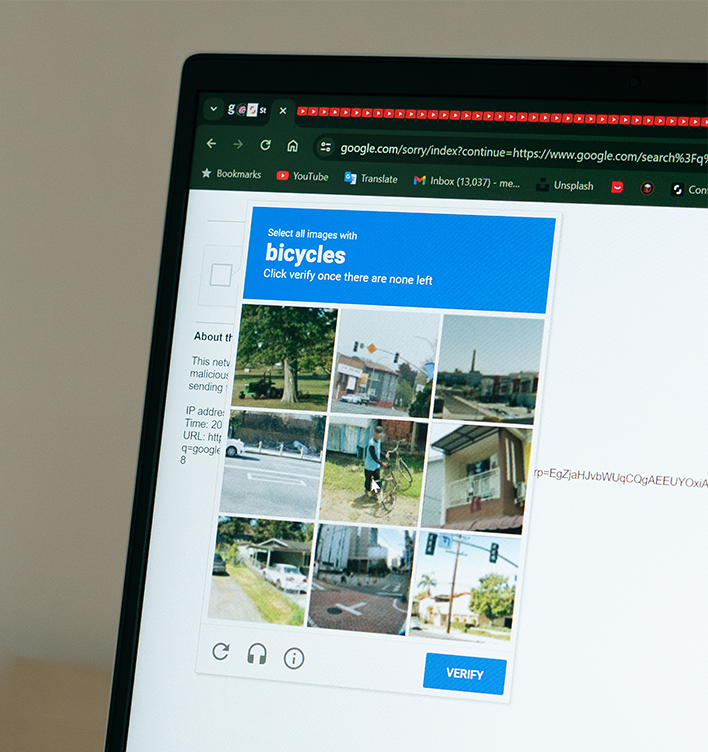This blog is a continuation of what comparisons can be made for CAPTCHA accessibility on websites, inspired from AXSChat Podcast.
After finishing the original blog, I decided to expand and tell you a bit about an area of assistive technology features that should be used and be accessible within a digital platform, whether on a website, document, or any other digital information.
This specific blog features the problems with CAPTCHA accessibility and the issues ic can present on digital platforms.
What Is A Website CAPTCHA?
I am sure that many of you have encountered one of these before online. But just in case you haven’t, a CAPTCHA distinguishes between a human user and a robot user.
These are presented to users because many scammers use bots to fill in online forms and interfere with the company’s website and employees. Staff for these businesses need to concentrate on human activity online and not waste their time with interfering robots.
Advancements With CAPTCHAs
I must say that CAPTCHAs have greatly improved over time. Previously, users were only presented with blurry colours and missed-shaped text that could be interpreted as normal text. This was difficult for any user to complete, let alone for someone who could not see the picture properly. As a result, many people were shut out from being able to complete a task on a website.
Over time, CAPTCHAs progressed to include audio. However, when it was first introduced, the auditory track was often indecipherable, ending up with the same result as before. Nowadays, I find that if an audio CAPTCHA is given as a choice, 9 times out of 10, I get it correct and can complete the process I am on.
Problems With CAPTCHA Accessibility Online
It is not only people who can’t see that face problems with website CAPTCHA accessibility. People with motor or cognitive disabilities also experience difficulties completing some of these actions.
Some methods of CAPTCHAs used entail visitors having to complete a puzzle to be able to bypass the CAPTCHA.
This includes actions such as having to:
- Match pictures up with the question. For example, you need to tick all the squares in an image that shows cats, which is not accessible.
- Complete simple sums like 2 + 2 =
- Answer questions like ‘What colour is snow?’
Answers that a computer can’t simulate by putting in any answer to pretend that they are human. Personally, I think that the simple questions are the most inclusive choice, as if you are able to fill in any other questions on the procedure, then the simpler CAPTCHA should be accessible.
An Everyday Comparison Of CAPTCHA Accessibility Problems
Imagine if someone came to your door with a parcel you ordered, but they would not give it to you unless you put in ‘the 4-digit number of the day’. You have no idea what the number is, and the delivery person says you must guess correctly to get the parcel. Another company could use ‘today’s favourite colour’. Well, unless you are extremely lucky, you are not going to get your parcel.
What made me think of this is when I was ordering some alcohol online, the delivery driver asked for my ID to make sure that I was over 18. To start with, I am over 50 years old and do not have a driver’s licence or any other photo ID. Luckily, my wife was at home and we have come across this before, so she could present her driving licence instead. That aftershave cream I use must be working well if I did not look over 18, lol.
This situation of CAPTCHAs is difficult for website developers, as they don’t want bots answering their questions. However, they must remember that many people need to be included.
With AI becoming more developed, CAPTCHAs will have to be more inventive and inclusive in the future, so I look forward to seeing how this progresses over time in removing online barriers.
Eliminating Inaccessible Digital Platforms
I know I have used this last paragraph at the end of each of this series of blogs, but it relays the important message of all the blogs written:
These are just a few comparisons between most people’s everyday life experiences and one of the inaccessible features of digital information in their life. However, there really is no need for any inaccessible areas, as there are always alternatives.
Think about when you could not get access to something. Whether it is in a shop or around your normal life experiences. There is no real reason why you should not be able to gain access. It is usually due to someone having made it inaccessible to you because of the design and not thinking of your individual needs as a customer in a specific situation.
It’s time to make a change and be inclusive.
Over the next few months, I’ll be blogging about ways that you can adapt your websites to achieve digital accessibility and improve the user experience for everyone.
For more details about how we can help with website accessibility testing, please get in touch with our team today.







